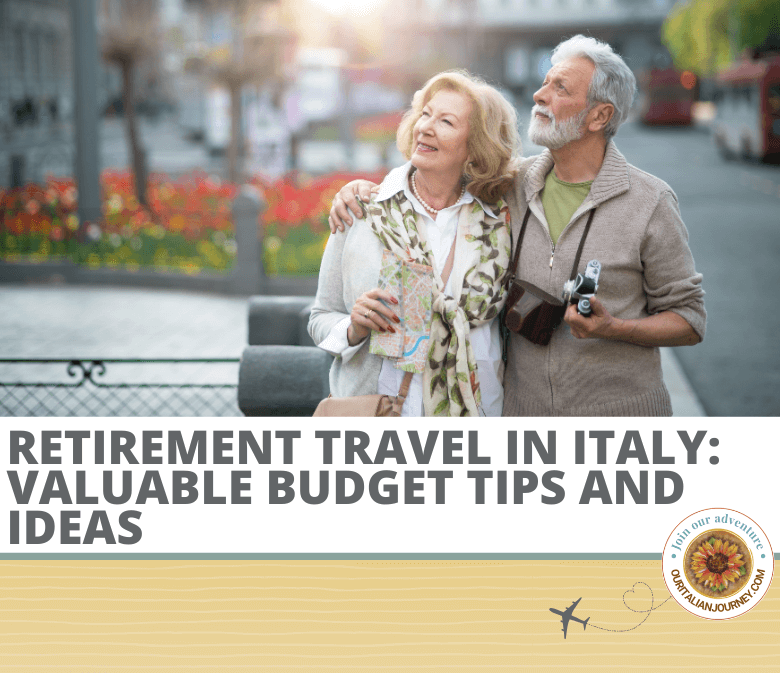Thinking of retirement travel? Retirement might be the best time to travel—and there’s no place more rewarding to explore than Italy. With more flexibility in your schedule and a lifetime of experience behind you, you can slow down and truly enjoy the journey. Whether planning your first big trip post-retirement or a seasoned traveler looking for a new way to see Italy, this guide is packed with practical advice and real-world tips designed with mature travelers in mind.
From saving money without sacrificing comfort to confidently navigating Italy solo, here’s everything you need to know to make the most of your Italian adventure.
This post contains affiliate links that help keep this website running. By purchasing through our links, we make a small commission at no extra charge to you. Thank you for your support!
Why Retirees Love Italy (And Why It Works So Well)
Italy naturally suits a slower, more immersive style of travel. The pace of life encourages you to linger over meals, explore on foot, and savor each moment. That’s not just poetic—it’s practical- it is how it is! If you no longer need to rush through a two-week vacation crammed between work obligations, you can travel smarter, stay longer in each place, and really absorb the beauty of your surroundings.
Retirees often tell us they love:
- Every town’s deep history and culture—even the smallest villages.
- The walkable towns, with pedestrian zones and charming alleys.
- Affordable local food, especially when shopping at neighborhood markets or dining in family-run trattorias.
- A healthcare system that’s reputable and accessible- just in case.
- The ease of getting around without a car, especially by train.
- And maybe most of all, retirees love that Italy rewards curiosity, not speed.
Retirement Travel Budget (Without Feeling Like You’re on a Budget)
Italy doesn’t have to be expensive, especially if you travel flexibly. One of the biggest advantages retirees have is being able to avoid high season. Visiting during the shoulder months (April–June and September–October) means better prices on flights and accommodations, fewer crowds, and milder weather.
A few ways to save without sacrificing the experience:
- Stay longer in fewer places. Weekly apartment rentals are often cheaper per night than hotels, making you feel like a local. You’ll save money by cooking simple meals with fresh ingredients from local markets.
- Choose smaller towns or lesser-known cities. Florence and Rome are excellent, but towns like Arezzo, Parma, or Lecce offer just as much charm at a lower cost.
- Take regional trains. They’re slower but scenic, easy to navigate, and far cheaper than the high-speed ones.
- Skip group tours unless you want them. Italy is easy to travel independently with just a little planning. Use apps like Trenitalia, Google Maps, and even Google Translate for a smooth experience.
Italy is one of the best countries to stretch your travel budget without compromising quality if you’re on a fixed income or just trying to make your retirement dollars go farther.
Can I Travel to Italy Alone in Retirement? Absolutely—Here’s How
Solo travel isn’t just for 20-somethings with backpacks. More and more retirees—especially women—are embracing solo travel later in life, and Italy is a fantastic place to start. It’s safe, friendly, and enriching for those exploring independently.
Still, solo retirement travel at any age comes with its challenges and considerations. Here’s what to keep in mind:
And don’t underestimate the freedom of solo travel—eat when you want, visit what interests you, and experience Italy on your terms.
A Guidebook but not in the Traditional Sense
Embark on an Italian adventure. Dive into the rich tapestry of each town, with insights into what to see, festivals and traditions, how to get there, plus the local food and wine you’ll enjoy—separate chapters on the seasons, national holidays, and an extensive rail travel section. Let us be your guide to these Tuscan towns!

A Few Things Travel Guides Don’t Always Tell You
This isn’t your average packing list. It’s based on some real-world insights we’ve gained over the years—especially useful for travelers who aren’t exactly carrying a backpack and running for trains. We always try and pack light – a smaller piece of luggage is so much better!
Cobblestones and comfort matter. Stylish shoes are great, but bring a supportive, broken-in pair for those uneven streets. You’ll thank yourself on day two.
Stairs are everywhere. Many historic buildings, including hotels and Airbnb rentals, don’t have elevators. Always ask before booking.
Hydration and rest are essential. Don’t feel guilty about an afternoon nap or lingering over a drink in the shade. That’s not “wasting time”—that’s Italian time.
Carry small cash and coins. Many small shops and cafés still prefer cash. Keep coins handy for public restrooms, too. They are normally €1 but we’ve experienced a few requiring €1,50.
Look for age-based discounts. Museums and train services sometimes offer reduced prices for us older people, but you may need to ask or show ID.
Final Thoughts: The Italy You’ve Always Wanted
Italy isn’t just a destination. For many retirees, it’s fulfilling a lifelong dream (like ours). And here’s the secret: when you travel later in life, you bring a perspective that makes everything richer. Well, that’s just my opinion. You notice more. You appreciate details others might rush past, and you know how precious time is, and you’re finally giving yourself the gift of slowing down.
So, whether you’re planning a solo trip to Tuscany, a month in a seaside town, or your very first visit to Italy, remember this:
You don’t need to see it all—you need to be open to the experience. Take your time. Ask questions. Get lost on purpose. And most of all, trust that it’s not too late to travel boldly, even if you’re doing it a little more slowly.
Please comment with your thoughts! I’d love to know…


Did you find this post helpful? Let us know by leaving a comment below. Don’t forget to join us on Facebook, Instagram, Pinterest, and our YouTube Channel









I’ve been to Italy 6 times, 4 on tours. I want to explore the villages of Umbria and eastern Tuscany, where renting a car is necessary. I’ll be mid-70s when I can do this and, while I’m strong and active, I’m concerned car rental companies may be hesitant to rent to an older, solo traveler.
Great comment, Candace! Gary’s 75 and has no issues renting a car. We have friends in their 80s here with no issues either. Perhpas you might enjoy our new travel guidebook, “Tuscany Treasures,” and we are actually working on Umbria now (giggles)! Keep us posted on your travels!
Love this post! I’m thankful for all of the travel that we did while working, but now that we are retired, it is so much better to be able to take our time and really explore cities, both small and large.
I couldn’t have said it better myself, JoAn. Thanks so much!